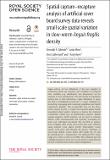Files in this item
Spatial capture-recapture analysis of artificial cover board survey data reveals small scale spatial variation in slow-worm Anguis fragilis density
Item metadata
| dc.contributor.author | Schmidt, Benedikt R. | |
| dc.contributor.author | Meier, Anita | |
| dc.contributor.author | Sutherland, Chris | |
| dc.contributor.author | Royle, J. Andy | |
| dc.date.accessioned | 2021-04-09T09:30:08Z | |
| dc.date.available | 2021-04-09T09:30:08Z | |
| dc.date.issued | 2017-09-13 | |
| dc.identifier | 272476000 | |
| dc.identifier | 53469a3e-ea1f-491d-97c7-d646868b0dff | |
| dc.identifier | 85029440122 | |
| dc.identifier.citation | Schmidt , B R , Meier , A , Sutherland , C & Royle , J A 2017 , ' Spatial capture-recapture analysis of artificial cover board survey data reveals small scale spatial variation in slow-worm Anguis fragilis density ' , Royal Society Open Science , vol. 4 , no. 9 , 170374 . https://doi.org/10.1098/rsos.170374 | en |
| dc.identifier.issn | 2054-5703 | |
| dc.identifier.other | ORCID: /0000-0003-2073-1751/work/87404642 | |
| dc.identifier.uri | https://hdl.handle.net/10023/22992 | |
| dc.description.abstract | Vague and/or ad hoc definitions of the area sampled in monitoring efforts are common, and estimates of ecological state variables (e.g. distribution and abundance) can be sensitive to such specifications. The uncertainty in population metrics due to data deficiencies, vague definitions of space and lack of standardized protocols is a major challenge for monitoring, managing and conserving amphibian and reptile populations globally. This is especially true for the slowworm (Anguis fragilis), a cryptic and fossorial legless lizard; uncertainty about spatial variation in density has hindered conservation efforts (e.g. in translocation projects). Spatial capture-recapture (SCR) methods can be used to estimate density while simultaneously and explicitly accounting for space and individual movement. We use SCR to analyse mark-recapture data of the slow-worm that were collected using artificial cover objects (ACO). Detectability varied among ACO grids and through the season. Estimates of slow-worm density varied across ACO grids (13, 45 and 46 individuals ha-1, respectively). The estimated 95% home range size of slow-worms was 0.38 ha. Our estimates provide valuable information about slow-worm spatial ecology that can be used to inform future conservation management. | |
| dc.format.extent | 8 | |
| dc.format.extent | 426657 | |
| dc.language.iso | eng | |
| dc.relation.ispartof | Royal Society Open Science | en |
| dc.subject | Abundance | en |
| dc.subject | Artificial cover object | en |
| dc.subject | Home range | en |
| dc.subject | Reptile | en |
| dc.subject | Spatial capture-recapture | en |
| dc.subject | Translocation | en |
| dc.subject | QA Mathematics | en |
| dc.subject | QH301 Biology | en |
| dc.subject | DAS | en |
| dc.subject.lcc | QA | en |
| dc.subject.lcc | QH301 | en |
| dc.title | Spatial capture-recapture analysis of artificial cover board survey data reveals small scale spatial variation in slow-worm Anguis fragilis density | en |
| dc.type | Journal article | en |
| dc.contributor.institution | University of St Andrews. Statistics | en |
| dc.contributor.institution | University of St Andrews. Centre for Research into Ecological & Environmental Modelling | en |
| dc.identifier.doi | 10.1098/rsos.170374 | |
| dc.description.status | Peer reviewed | en |
This item appears in the following Collection(s)
Items in the St Andrews Research Repository are protected by copyright, with all rights reserved, unless otherwise indicated.

